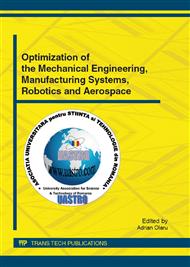p.26
p.35
p.46
p.50
p.58
p.70
p.75
p.87
p.98
Validation of the Mathematical and Numerical Models for Artillery Barrels Autofrettage Based on Hydrostatic Procedure
Abstract:
The research of advanced gun barrels focuses on materials or the combination between advanced materials and new innovative processes that enable the increase of the life cycle and performances of all calibers cannons. In addition to the investigation of new materials, considerable efforts were made for developing new techniques. The paper describes a theoretical framework validated with the experimental tests for increasing mechanical properties of thick-walled tubes subjected to high interior pressure loads. The theoretical model established a mathematical model of calculus for non-linear environments in the case of self-hooping or autofrettaging of the thick-walled tubes. The mathematical model was validated with experimental tests performed in the Mechanical Engineering Laboratory of the Military Technical Academy in Bucharest on a standard tension test specimens collected from the abutment barrel made out of alloyed steel. Finally, the present paper introduces some theoretical guidelines of hydrostatic procedure in the field of artillery barrels manufacturing, as well as experimental data obtained after using the autofrettage procedure.
Info:
Periodical:
Pages:
58-69
Citation:
Online since:
June 2012
Authors:
Keywords:
Price:
Сopyright:
© 2012 Trans Tech Publications Ltd. All Rights Reserved
Share:
Citation:


